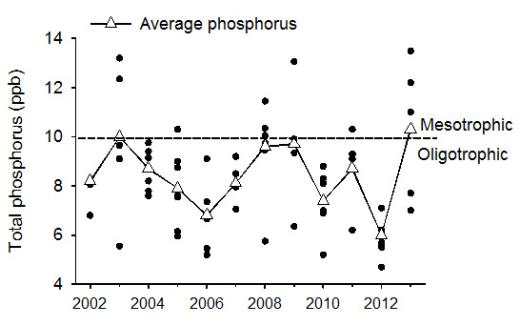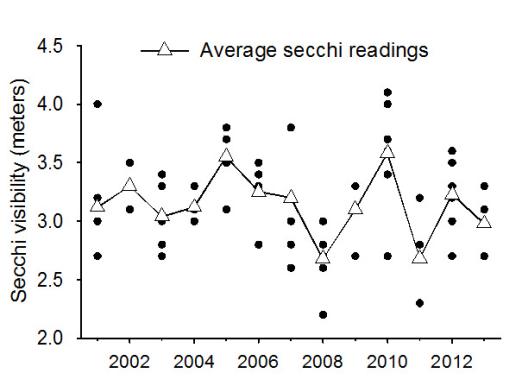
In 2013, we purchased a YSI tester to sample our water for temperature, oxygen, dissolved ions, pH, and oxidation reduction potential. View Mike Maceina's 2014 AGM PowerPoint presentation describing the results of his YSI sampling (1800 samples!). In addition, we began E. coli testing at three locations on Wahwashkesh Lake in 2014.
During the past 13 years, volunteers from Wahwashkesh Lake have taken water quality samples on the lake in cooperation with the Ontario Ministry of the Environment (MOE). Both nutrient level and water clarity show no overall negative trends as of 2014. However, continued monitoring of water quality in Wahwashkesh Lake is important to detect if any changes do occur. Leaching of nutrients from faulty or non-existent septic systems and upstream inputs of nutrients are issues that we should closely watch in Wahwashkesh Lake.
The MOE publishes the data collected from its Lake Partner Program web site. You can search the MOE site for Wahwashkesh and review the data collected for a specific station on Wahwashkesh Lake. In addition, you can read Mike Maceina's full report ![]() (145 kb) provided at the 2014 AGM. For an archived account, you can read Pat Ferris's 2005 report.
(145 kb) provided at the 2014 AGM. For an archived account, you can read Pat Ferris's 2005 report.
NUTRIENT LEVEL
Figure 1 shows total phosphorous (TP) concentrations on our lake over time for specific stations as well as average phosphorous for all WWK stations. The total phosphorous concentration of a lake is one of the best indicators of its nutrient level. We can see from the figure that the lake-wide average TP tends to be in the oligotrophic zone (i.e., low nutrients and algae production).

Figure 1. Wahwashkesh Lake nutrient level versus time
WATER CLARITY
Figure 2 shows water clarity readings at specific stations on our lake over time. Many factors affect water clarity:
- nutrient and algae levels
- dissolved organic carbon (DOC) level
- turbidity

Figure 2. Wahwashkesh Lake water clarity versus time
The purpose of tracking clarity is to observe trends that would reflect macro changes in a lakes' overall health. Currently, there are no trends noticed in the clarity of Lake Wahwashkesh waters.
Though the major factors that affect water clarity are largely out of our control, we can contribute to the conservation of our currently healthy nutrient and clarity levels by considering the following actions:
- install and maintain approved septic systems
- refrain from using soaps or shampoos in the lake; if unavoidable, use environmentally friendly products
- limit shoreline development
- be aware of your existing shoreline and dock areas for sources of contamination
- avoid gasoline spills
- keep pressure-treated wood out of contact with lake water
- minimize erosion and run-off into the lake